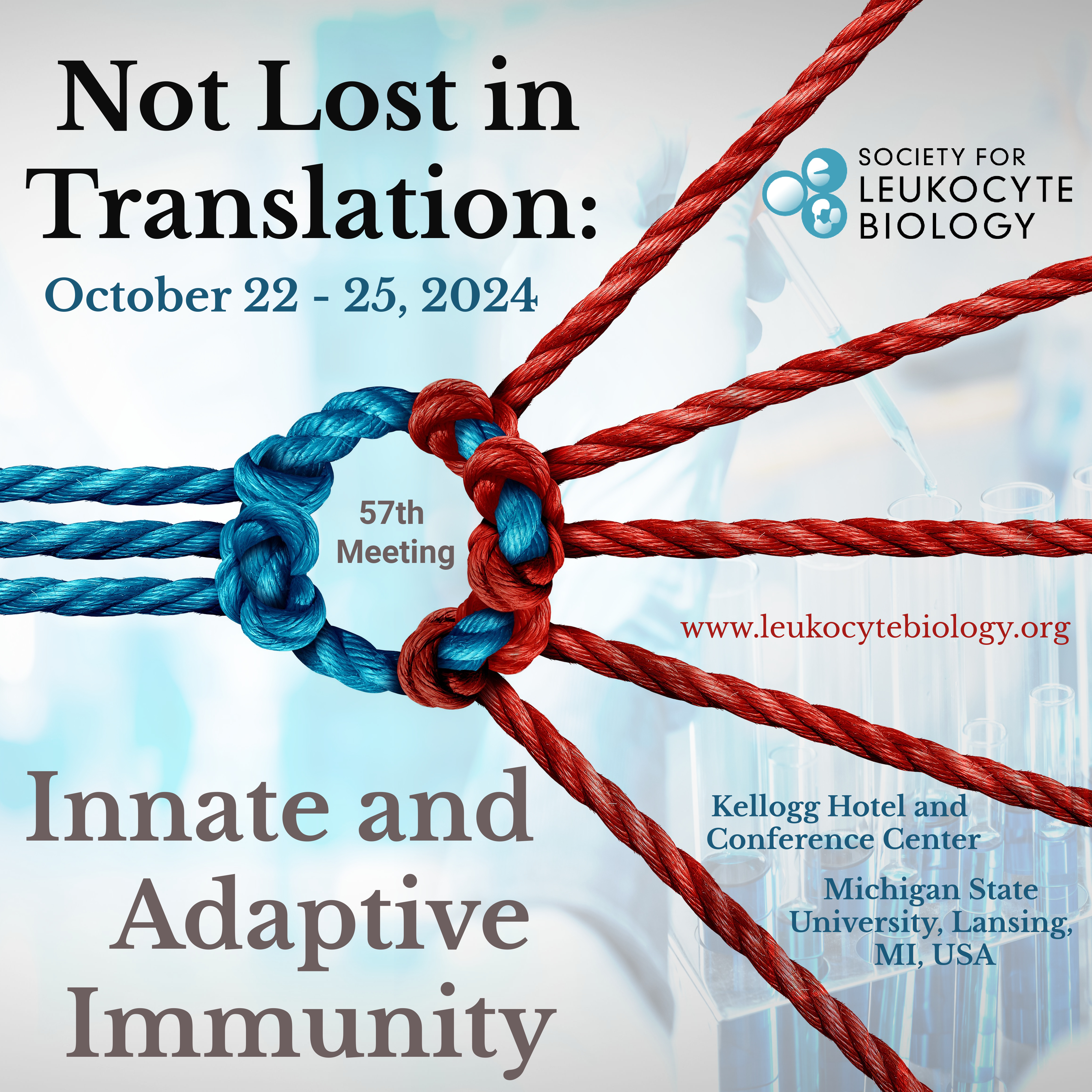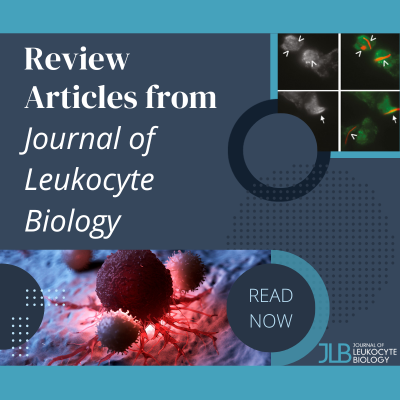| JLB TOC Vol 111 Issue 1 |
ISSUE INFORMATION Issue InformationPages: 1-5 | First Published:28 December 2021 EDITORIAL Differential training of innate leukocytes getting compartmentalized Shuo Geng, Liwu Li
Pages: 7-8 | First Published:12 October 2021 SPOTLIGHT ON LEADING EDGE RESEARCH Limited role of the spleen in a mouse model of trained immunity: Impact on neutrophilia Anaísa V. Ferreira, Rienke F. Uijen, Ozlem Bulut, Marien I. de Jonge, Jorge Domínguez-Andrés, Mihai G. Netea
Pages: 9-17 | First Published:01 October 2021 SLB Member Issue – Extracellular Vesicles in Immunity Guest Editors: Mallary Greenlee-Wacker, Laxmi Yeruva, Véronique Witko-Sarsat PRIMARY RESEARCH Adipose‐derived stem cell‐derived extracellular vesicles inhibit neuroblastoma growth by regulating GABBR1 activity through LINC00622‐mediated transcription factor AR Mengguo Guo, Dongpeng Li, Yawen Feng, Mu Li, Bo Yang
Pages: 19-32 | First Published:27 August 2021 Plasma extracellular vesicles released after severe burn injury modulate macrophage phenotype and function Micah L. Willis, Cressida Mahung, Shannon M. Wallet, Alexandra Barnett, Bruce A. Cairns, Leon G. Coleman Jr., Robert Maile
Pages: 33-49 | First Published:03 August 2021 REVIEWS Role of extracellular vesicles in atherosclerosis: An update Pierre-Michaël Coly, Chantal M. Boulanger
Pages: 51-62 | First Published:08 September 2021 Platelet extracellular vesicles in COVID‐19: Potential markers and makers Florian Puhm, Louis Flamand, Eric Boilard
Pages: 63-74 | First Published:03 November 2021 Extracellular vesicles in inflammation: Focus on the microRNA cargo of EVs in modulation of liver diseases Mrigya Babuta, Gyongyi Szabo
Pages: 75-92 | First Published:10 November 2021 The emerging therapeutic potential of extracellular vesicles in trauma Nijmeh Alsaadi, Amudan J. Srinivasan, Anupamaa Seshadri, Matthew Shiel, Matthew D. Neal, Melanie J. Scott
Pages: 93-111 | First Published:17 September 2021 CELL DEVELOPMENT, DIFFERENTIATION AND TRAFFICKING More than neutrophils: Lin(+)Ly6G(+)IL‐5Rα(+) multipotent myeloid cells (MMCs) are dominant in normal murine bone marrow and retain capacity to differentiate into eosinophils and monocytes Brian M. Jeong, Matthew T. Walker, Raul Rodriguez, Mackenzie E. Coden, Reina Nagasaka, Ton C. Doan, Yuliya Politanska, Hiam Abdala-Valencia, Sergejs Berdnikovs
Pages: 113-122 | First Published:15 April 2021 INFLAMMATION, EXTRACELLULAR MEDIATORS AND EFFECTOR MOLECULES Metallothioneins alter macrophage phenotype and represent novel therapeutic targets for acetaminophen‐induced liver injury Lindsey Devisscher, Sanne Van Campenhout, Sander Lefere, Sarah Raevens, Laurentijn Tilleman, Filip Van Nieuwerburgh, Hannelore P. Van Eeckhoutte, Anne Hoorens, Michael A. Lynes, Anja Geerts, Debby Laukens, Hans Van Vlierberghe
Pages: 123-133 | First Published:16 March 2021 Hspa8 and ICAM‐1 as damage‐induced mediators of γδ T cell activation Margarete D. Johnson, Michel F. Otuki, Daniela A. Cabrini, Ross Rudolph, Deborah A. Witherden, Wendy L. Havran
Pages: 135-145 | First Published:13 April 2021 HOST DEFENSE AND PATHOPHYSIOLOGY Metabolic and functional impairment of CD8+ T cells from the lungs of influenza‐infected obese mice William D. Green, Abrar E. Al-Shaer, Qing Shi, Kymberly M. Gowdy, Nancie J. MacIver, J. Justin Milner, Melinda A. Beck, Saame Raza Shaikh
Pages: 147-159 | First Published:13 April 2021 TRANSLATIONAL AND CLINICAL IMMUNOLOGY Innate lymphoid cell recovery and occurrence of GvHD after hematopoietic stem cell transplantation Christelle Piperoglou, Guillaume Larid, Blandine Vallentin, Laura Balligand, Adeline Crinier, Nathalie Banzet, Catherine Farnarier, Elena Gomez-Massa, Aranzazu Cruz Adalia, CRYOSTEM Consortium , Gérard Michel, Claire Galambrun, Vincent Barlogis, Eric Vivier, Frédéric Vély
Pages: 161-172 | First Published:13 April 2021  Graphical Abstract Patients with graft-versus-host disease after hematopoietic stem cell transplantation showed slow recovery of circulating innate lymphoid cells and a reduced number of activated ILCP; this is consistent with a non-redundant role of this ILC subset in preventing this life-threatening disorder under lymphopenic conditions. REVIEWS A review of signaling and transcriptional control in T follicular helper cell differentiation Andrew P. Hart, Terri M. Laufer
Pages: 173-195 | First Published:18 April 2021 The regulatory role of insulin in energy metabolism and leukocyte functions Walter David Cruz-Pineda, Isela Parra-Rojas, Hugo Alberto Rodríguez-Ruíz, Berenice Illades-Aguiar, Inés Matia-García, Olga Lilia Garibay-Cerdenares
Pages: 197-208 | First Published:16 March 2021 Neuroimmune regulatory networks of the airway mucosa in allergic inflammatory disease E. Evonne Jean, Olivia Good, Juan M. Inclan Rico, Heather L. Rossi, De'Broski R. Herbert
Pages: 209-221 | First Published:15 April 2021 K27‐linked noncanonic ubiquitination in immune regulation Qingqing Zhou, Jun Zhang
Pages: 223-235 | First Published:15 April 2021 Cellular immune responses in the pathophysiology of preeclampsia Derek Miller, Kenichiro Motomura, Jose Galaz, Meyer Gershater, Eun D. Lee, Roberto Romero, Nardhy Gomez-Lopez
Pages: 237-260 | First Published:13 April 2021 COVID-19 INITIAITVE Monoclonal antibodies capable of binding SARS‐CoV‐2 spike protein receptor‐binding motif specifically prevent GM‐CSF induction Xiaoling Qiang, Shu Zhu, Jianhua Li, Weiqiang Chen, Huan Yang, Ping Wang, Kevin J. Tracey, Haichao Wang
Pages: 261-267 | First Published:24 March 2021 T cell counts and IL‐6 concentration in blood of North African COVID‐19 patients are two independent prognostic factors for severe disease and death Brahim Belaid, Lydia Lamara Mahammad, Belgacem Mihi, Sarah Yasmine Rahali, Asma Djidjeli, Zineb Larab, Lilya Berkani, Ismahane Berkane, Wafa Sayah, Fatma Merah, Nouzha Zhor Lazli, Lylia Kheddouci, Ahmed Kadi, Mourad Ouali, Rachida Khellafi, Dalila Mekideche, Assia Kheliouen, Soraya Ayoub, Réda Malek Hamidi, Fawzi Derrar, Merzak Gharnaout, Ines Allam, Réda Djidjik
Pages: 269-281 | First Published:02 February 2021 TRB sequences targeting ORF1a/b are associated with disease severity in hospitalized COVID‐19 patients Jorn L.J.C. Assmann, P. Martijn Kolijn, Benjamin Schrijver, Adriaan J. van Gammeren, Daan W. Loth, Ton A.A.M. Ermens, Willem A. Dik, Vincent H.J. van der Velden, Anton W. Langerak
Pages: 283-289 | First Published:13 April 2021 |



























